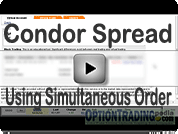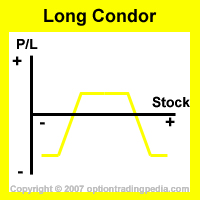How Does The Condor Spread Work in Options Trading?
Condor Spread - Introduction
Do you want to learn how to profit no matter if the stock goes upwards (by a little), downwards (by a little) or even sideways? In all 3 directions? Yes, the Condor Spread is your solution!
The Condor Spread is an advanced neutral option trading strategy which profits from stocks that are stagnant or trading within a tight price range (Range Bound).
It is a cousin of the butterfly spread but involves 4 strike prices instead of 3 strike prices, resulting in a much wider profitable range at the
cost of a lower maximum profit.
The Condor Spread is an option strategy that is still confusing
many option traders and option trading information websites. Almost 90% of the websites out there today (March 2007) still confused Condor Spreads with
Iron Condor Spreads. Iron Condor Spreads are credit spreads
while Condor Spreads are debit spreads.
|
|
Each of them has their own strengths and weaknesses. Here is a table explaining the differences:
| Condor Spread | Iron Condor Spread | Butterfly Spread | Iron Butterfly Spread | |
| Debit/Credit | Debit | Credit | Debit | Credit |
| Max Profit | Low | High | Higher | Highest |
| Max Loss | Highest | Higher | High | Low |
| Cost of Position | High | NIL | Low | NIL |
| Profitable Range | Wide | Widest | Narrow | Wider |
As you can see from the table above, all of the above complex neutral option strategies comes with their own strengths and weaknesses. Option trading strategies are all about trade-offs. There are no single option trading strategy that has the best of all worlds. From a reward/risk ratio point of view, a Condor Spread would be inferior to the rest of the complex neutral strategies as it has the lowest maximum profit potential while having the highest maximum loss potential.
When To Use Condor Spread?
One should use a Condor Spread when one expects the price of the underlying asset to change very little or within a very tight trading range over the life of the option contracts.
How To Use Condor Spread?
There are two ways to establish a Condor Spread. One way is to use only call options. We call this a "Call Condor Spread". The other way is to
use only put options. We call that a "Put Condor Spread". Either way performs the same as long as the underlying asset remains within the profitable
price range upon option expiration.
Either way, the composition of the Condor Spread is the same. It involves buying to open 1 far In The Money (ITM) option,
selling to open 1 In The Money option, selling to open 1 Out of The Money (OTM) option
and buying to open 1 further Out of The Money (OTM) option.
(a)Buy One Far ITM + (b)Sell One ITM + (c)Sell One OTM + (d)Buy One Far OTM
Establishing Call Condor Spread
Establishing a Call Condor Spread involves buying to open 1 far ITM call option, selling to open 1 ITM call option, selling to open 1 OTM call option
and then finally buying to open a further OTM call option.
The choice of which strike prices to buy the long legs (trades a and d above) at depends on the range within which the underlying asset is expected to trade in. The further away from the money the 2 long legs are, the lower the risk (as the underlying stock needs to move further in order to exit the breakeven range), and the lower the potential profits (as the further in the money options will cost a lot more to buy).
A Condor Spread is therefore an extremely advanced neutral strategy where a trader gets to control the range within which the Condor Spread is profitable as well as the range within which the Condor Spread will hit its maximum profit potential. You can also skew the risk/reward profile of the Condor spread so that the position makes a loss only on one side of the trade, not both, through the use of a Call Broken Wing Condor Spread or Put Broken Wing Condor Spread.
|
Call Condor Spread Example
Assuming QQQQ trading at $43.57. Sell To Open 1 contract of Jan $43 Call at $1.63 Sell To Open 1 contract of Jan $44 Call at $1.03 Buy To Open 1 contract of Jan $45 Call at $0.60 Net Debit = ($2.38 - $1.63 - $1.03 + $0.60) x 100 = $32.00 per position |
In the above example, we are expecting the QQQQ to trade within a price range of between $42 to $45 upon expiration and achieving the maximum profit
potential of the Condor Spread when QQQQ is within $43 to $44.
Establishing Put Condor Spread
Establishing a Put Condor Spread is exactly the same as establishing a Call Condor Spread except that put options are used instead. The resultant net debit and profitable range of a Put Condor Spread are theoretically the same as you would use call options in a Call Condor Spread, however, in practise, Call options and Put options do not cost the same to put on. In stocks that are likely to be more bullish, its call options will be more expensive than its put options and vice versa. Therefore, a trader needs to calculate whether a Call Condor Spread or a Put Condor Spread is cheaper to establish based on the prevailing prices.
|
Put Condor Spread Example
Assuming QQQQ trading at $43.57 Buy To Open 1 contract of Jan $42 Put at $0.59 Sell To Open 1 contract of Jan $43 Put at $0.85 Sell To Open 1 contract of Jan $44 Put at $1.24 Buy To Open 1 contract of Jan $45 Put at $1.84 Net Debit = ($0.59 - $0.85 - $1.24 + $1.84) x 100 = $34.00 per position |
We see that the Call Condor Spread is cheaper to establish than the Put Condor Spread today, so the Call Condor Spread should be used instead.
Trading Level Required For Condor Spread
A Level 3 options trading account that allows the execution of debit spreads is needed for the Condor Spread. There are also brokers that require level 4 or 5 accounts. Please check with your specific broker. Read more about Options Account Trading Levels.
Profit Potential of Condor Spread :
Condor spreads achieve their maximum profit potential at expiration if the price of the underlying asset is within the 2 middle strike prices. The profitability of a condor spread can also be enhanced or better guaranteed by legging into the position properly.
Profit Calculation of Condor Spread:
Maximum Profit = (Net Extrinsic Value in the position) x 100
Profit % = (Max Profit - Net Debit) / Net Debit
|
Profit Calculation of Condor Spread
From the above Call Condor Spread example : Maximum Profit = (1.06 + 1.03) - (0.81 + 0.60) = 2.09 - 1.41 = $0.68 x 100 = $68 Profit % = ($68 - $32) / $32 = 115% |
Risk / Reward of Condor Spread:
Upside Maximum Profit: Limited
Maximum Loss: Limited to net debit paid
Break Even Point (Profitable Range) of Condor Spread:
A Condor Spread is profitable if the underlying asset expires within the profitable range bounded by the upper and lower breakeven points.
1. Lower Breakeven Point : Net Debit + Lower Strike Price
|
Condor Spread Calculation
Net Debit = $0.32 , Lower Strike Price = $42.00 Lower Breakeven Point = $0.32 + $42.00 = $42.32. |
And
2. Upper Breakeven Point : Higher Strike Price - Net Debit
|
Condor Spread Calculation
Net Debit = $0.32 , Higher Strike Price = $45.00 Higher Breakeven Point = $45.00 - $0.32 = $44.68. |
Profitable Range = $44.68 to $42.32 therefore a $2.36 range.
Advantages Of Condor Spread:
:: Large profit percentage due to low cost involve in executing the position.
:: Limited risk should the underlying asset rally or ditch unexpectedly. (unlike the Short Straddle)
:: Maximum loss and profits are predictable.
:: Wider profitable range than a Butterfly Spread.
:: Have customisable profitable range as well as maximum profit range.
:: Able to profit on stocks that are completely stagnant or trading within a tight range.
Disadvantages Of Condor Spread:
:: Larger commissions involved than simpler strategies with lesser trades.
:: Has a lower maximum profit potential than the other complex neutral option strategies.
:: Has a higher maximum loss potential than the other complex neutral option strategies.
Adjustments for Condor Spreads Before Expiration :
1. If the underlying asset has gained in price and is expected to continue rising, you could buy back the short call options and
hold the long call options.
2. If the underlying asset has dropped in price and is expected to continue dropping, you could sell the long call options and
hold the short call options. This action is only possible if your broker allows you to sell naked options.
3. Advanced option traders may also close out the short or long leg and then buy or short the undelying asset in order to
achieve a delta neutral position in order to protect whatever profit is left.
Condor Spread Videos

Condor Spread
using Simultaneous Order

|
Don't Know If This Is The Right Option Strategy For You? Try our Option Strategy Selector! |
| Javascript Tree Menu |
Important Disclaimer : Options involve risk and are not suitable for all investors. Data and information is provided for informational purposes only, and is not intended for trading purposes. Neither www.optiontradingpedia.com, mastersoequity.com nor any of its data or content providers shall be liable for any errors, omissions, or delays in the content, or for any actions taken in reliance thereon. Data is deemed accurate but is not warranted or guaranteed. optiontradinpedia.com and mastersoequity.com are not a registered broker-dealer and does not endorse or recommend the services of any brokerage company. The brokerage company you select is solely responsible for its services to you. By accessing, viewing, or using this site in any way, you agree to be bound by the above conditions and disclaimers found on this site.
Copyright Warning : All contents and information presented here in www.optiontradingpedia.com are property of www.Optiontradingpedia.com and are not to be copied, redistributed or downloaded in any ways unless in accordance with our quoting policy. We have a comprehensive system to detect plagiarism and will take legal action against any individuals, websites or companies involved. We Take Our Copyright VERY Seriously!
Site Authored by
